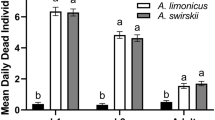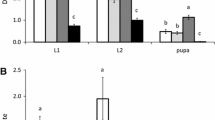Abstract
Data are presented that demonstrate the responsiveness ofChrysopa carnea Stephens larvae to kairomones in the moth scales ofHeliothis zea (Boddie). Rates of predation byC. carnea on eggs ofH. zea were increased whenH. zea moth scales or a hexane extract of the scales was applied to the search area under laboratory and greenhouse conditions.
Similar content being viewed by others
References
Bosch, R. van den, andHagen, K.S. 1966.Predaceous and parasitic arthropods in California cotton fields. University of California Agricultural Experimental Station Bulletin 820. 32 pp.
Burton, R.L. 1969.Mass rearing the corn earworm in the laboratory. U.S. Department of Agriculture, Agricultural Research Service (Ser.) 33–134. 8 pp.
Doutt, R.L., andHagen, K.S. 1949. Periodic colonization ofChrysopa californica as a possible control of mealybugs.J. Econ. Entomol. 42:560–561.
Ehler, L.E., andBosch, R. van den 1974. An analysis of natural biological control ofTrichoplusia ni (Lepidoptera:Noctuidae) on cotton in California.Can. Entomol. 106:1067–73.
Hagen, K.S., scSawall, E.F., Jr., andTassan, R.L. 1970. The use of food sprays to increase effectiveness of entomophagous insects.Tall Timb. Conf. Ecol. Anim. Control Habitat Manage. 2:59–81.
Hagen, K.S., Greany, P., Sawall, E.F., Jr., andTassan, R.L. 1976. Tryptophan in artificial honeydews as a source of an attractant for adultChrysopa carnea.Environ. Entomol. 5:458–468.
Jones, R.L., Lewis, W.J., Beroza, M., Bierl, B.A., andSparks, A.N. 1973. Host-seeking stimulants (kairomones) for the egg parasite,Trichogramma evanescens.Environ. Entomol. 2:593–596.
Laing, J. 1937. Host-finding by insect parasites. I. Observations on finding of hosts byAlysia manducator, Mormoniella vitripenosia, andTrichogramma evanescens.J. Anim. Ecol. 6:298–317.
Lewis, W.J., Sparks, A.N., andRedlinger, L.M. 1971. Moth odor: A method of host- finding byTrichogramma evanescens.J. Econ. Entomol. 64:557–558.
Lewis, W.J., Jones, R.L., andSparks, A.N. 1972. A host-seeking stimulant for the egg parasiteTrichogramma evanescens: Its source and a demonstration of its laboratory and field activity.J. Econ. Entomol. 65:1087–1089.
Lewis, W.J., Jones, R.L., Nordlund, D.A., andSparks, A.N. 1975a. Kairomones and their use for management of entomophagous insects: I. Evaluation of increasing rates of parasitization byTrichogramma spp. in the field.J. Chem. Ecol. 1:343–347.
Lewis, W.J., Jonfs, R.L., Nordlund, D.A., andGross, H.R., Jr. 1975b. Kairomones and their use for management of entomophagous insects: II. Mechanisms causing increases in rate of parasitization byTrichogramma spp.J. Chem. Ecol. 1:349–360.
Lingren, P.D., Ridgway, R.L., andJones, S.L. 1968. Consumption by several common arthropod predators of eggs and larvae of twoHeliothis species that attack cotton.Ann. Entomol. Soc. Am. 61:613–618.
Quaintance, A.L., andBrues, C.T. 1905.The cotton bollworm. U.S. Department of Agriculture Bureau Entomological Bulletin 50. 155 pp.
Reed, W. 1965.Heliothis armigera (H.B.) (Noctuidae) in western Tanganyika. II. Ecology and natural chemical control.Bull. Entomol. Res. 56:127–140.
Ridgway, R.L. 1969. Control of the bollworm and tobacco budworm through conservation and augmentation of predaceous insects.Tall Timb. Conf. Ecol. Anim. Control Habitat Manage. 1:127–142.
Ridgway, R.L., andJones, S.L. 1968. Field-cage releases ofChrysopa carnea for suppression of populations of the bollworm and the tobacco budworm on cotton.J. Econ. Entomol. 61:892–898.
Ridgway, R.L., andJones, S.L. 1969. Inundative releases ofChrysopa carnea for controlof Heliothis on cotton.J. Econ. Entomol. 62:177–180.
Scopes, N.E.A. 1969. The potential ofChrysopa carnea as a biological control agent ofMyzus persicae on glasshouse chrysanthemums.Ann. Appl. Biol. 64:433–438.
Vité, J.P., andWilliamson, D.L. 1970.Thanasimus dubius: Prey perception.J. Insect Physiol. 16:233–239.
Whitcome, W.H., andBell, K. 1964.Predaceous insects, spiders, and mites of Arkansas cotton fields. University of Arkansas Agricultural Experimental Station Bulletin 690. pp. 1–84.
Wilbert, H. 1974. Die Wahrnehmung von Beute durch die Eilarven vonAphidoletes aphidimyza (Cecidomyiidae).Entomophaga 19:173–181.
Wood, D.L., Browne, L.E., Bedard, W.D., Tilden, P.E., Silverstein, R.M., andRodin J.O. 1968. Response ofIps confusus to synthetic sex pheromones in nature.Science 159:1373–1374.
Author information
Authors and Affiliations
Additional information
Lepidoptera:Noctuidae
Neuroptera:Chrysopidae
In cooperation with the University of Georgia College of Agriculture Experiment Stations, Coastal Plain Station, Tifton, Georgia 31794.
Mention of a commercial or proprietary product in this paper does not constitute endorsement of this product by the USDA.
Rights and permissions
About this article
Cite this article
Lewis, W.J., Nordlund, D.A., Gross, H.R. et al. Kairomones and their use for management of entomophagous insects. J Chem Ecol 3, 483–487 (1977). https://doi.org/10.1007/BF00988191
Received:
Revised:
Issue Date:
DOI: https://doi.org/10.1007/BF00988191




